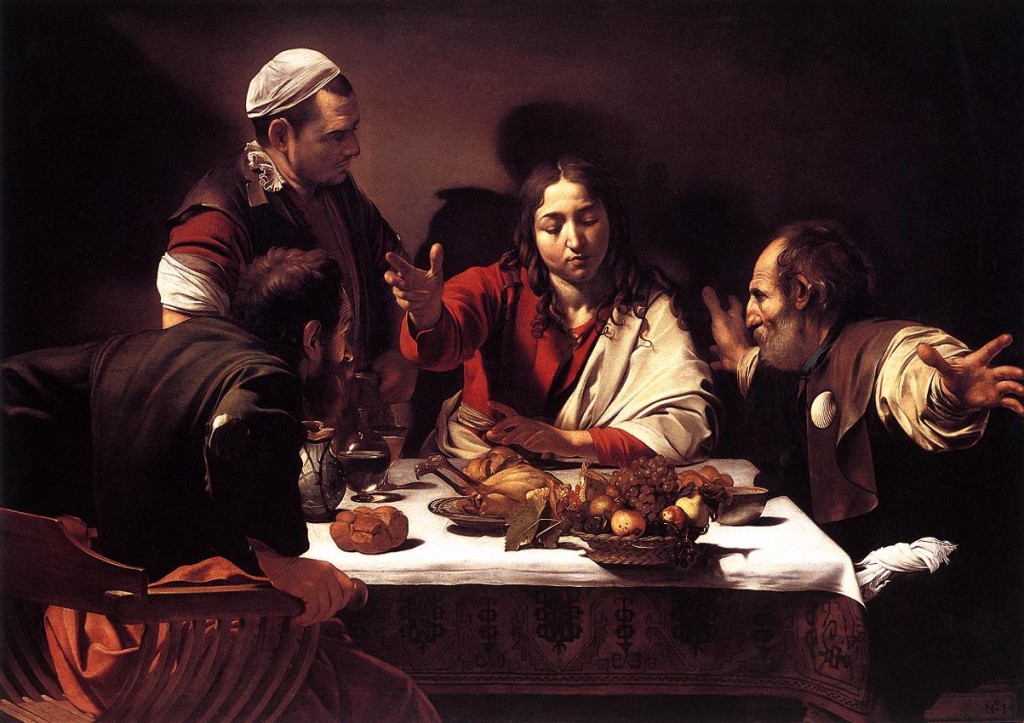The Supper at Emmaus
‘When he was at the table with them, he took bread, gave thanks, broke it and began to give it to them. Then their eyes were opened and they recognized him, and he disappeared from their sight.’ (Luke 24:30-31) The story of the Road to Emmaus describes how after the crucifixion Cleopas and another disciple encounter a man on their journey. It is only later over supper, when the man breaks and blesses the bread that the disciples see that he is the recently resurrected Jesus. This painting captures the very moment of Christ’s unveiling.
What may be interesting to point out is that in 1601 Caravaggio, though well-known in Rome he was not highly regarded by all. He was seen as revolutionary and was clearly trying to break with tradition. There are two main things that set him apart from his contemporaries. Firstly, he was stylistically unique because of his use tenebrism (heightened chiaroscuro), which brought drama to his works. Set against dark backgrounds his scenes had a distinctive ‘staged’ feel, paired with a naturalism which brought the story to life. This was something that was embraced by the Catholic Church during the Counter Reformation as it provoked emotional and spiritual contemplation. Secondly he painted ordinary people, not classically beautiful or idealised models. This sometimes caused his works to be rejected, as the Renaissance tradition had accustomed viewers to Biblical characters of otherworldly beauty. His originality set him apart from his rivals and probably annoyed those who were stuck in the Mannerist style. Admired or despised, either way he was famous.
So, to the painting in question. Bearing in mind all of the above, this image does not at first seem all that controversial. However, look at Christ. Have you ever seen him as an adult sans-beard? He was allegedly around his mid-thirties when he was crucified, but here he looks eternally childlike with his plump rosy cheeks and softly spiralled locks of hair. Enrobed in red and white, colours reminiscent of innocence and his recent Passion, he is illuminated by a spotlight. The composition is simple yet effective. The lines of the three men around Jesus (an innkeeper joins the two disciples) radiate from where he sits, dressed in ordinary and rather tatty cloths. The physical reaction of the disciples in the foreground are acutely observed (disregarding the poor perspective of Cleopas’ right hand), and evoke sensation. If this happened to you would you not jump out of your seat? The movement is very dramatic, and photographic in that it is instantaneous. It could be a film still or a scene from a play. By bringing this miracle to us in an ordinary setting, life-size and pretty much putting us at the table Caravaggio makes the divine real.
The table before Christ is set with props emblematic of the narrative; bread and a carafe of wine representing the Eucharist, a glass of water, and a basket of fruit showing the beginnings of decay, casting a fish-shaped shadow on the table cloth. In comparison to other Counter-Reformation artists of the time, Caravaggio is not loading his works with the traditional symbols used to narrate biblical scenes. And understandably so. They are unnecessary, and cutting them out means cutting away to the core of the human element. Going back to the idea of being a revolutionary painter, this restraint was virtually unheard of in Caravaggio’s world. Artists like Annibale Carracci and Rubens were very much traditionalists. From our perspective these unconventional elements may not seem particularly ballsy. But for the artist it was a risk, one which sometimes cost him time and money for commissions.
I suppose what I am trying to get at is that what we know about Caravaggio does not conjure visions of an artist of divine inspiration. He was a keen drinker and gambler, a lover of pretty young men and possessed a nasty aggressive streak, spending periods running from the law or being exiled. What little is known of him is not particularly favourable. What fascinates me, religious or not, is the emotional intensity of his works of the Church. Yes, he used non-idealised models, and yes the scenes are usually dark and sparse with only a light shaft or two to elucidate the allegory. But this is what makes his images so provocative and engaging. After all, a churchgoer on their knees in prayer is surely going to feel more compassion towards a realistic image than an untouchable heaven-bound character surrounded by winged-angel heads. The passage from Luke continues “He was a prophet, powerful in word and deed before God and all the people” (Luke 24:19), and this is precisely what Caravaggio is telling us.

